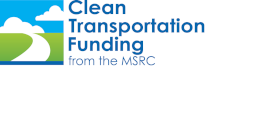Five years ago, the Bear Valley Unified School District was the first in its region to seize an opportunity presented by the MSRC to fund compressed natural gas (CNG) school bus technology. As a result, the district now provides its students with cleaner buses that significantly reduce pollution and emissions and improve the health and air quality of the region. Located in the Big Bear area, Bear Valley USD embarked on a two-year demonstration project with the MSRC in 2008 to test how CNG-fueled school buses would operate in a colder climate and a higher altitude environment.
“I wasn’t so sure that CNG would work here in Big Bear because of the altitude, the climate and the temperatures we deal with,” said Gail Hastain, Transportation Supervisor for the Bear Valley USD. “For the demonstration project, the MSRC funded two CNG school buses and a temporary fueling station as well, so it didn’t cost our district anything to give it a try. The program was successful and we were happy with the performance of the CNG buses and with the power that they had.”
Bear Valley USD tried CNG before anyone else did. “We are the only agency in the area that is using CNG,” Gail commented. “Nobody else would take that step. Because the MSRC paid for the entire demonstration project, there was no reason for us not to. The opportunity that the MSRC gave us was amazing.”
The school district recognized the clean air benefits that CNG school buses provide. “As a district, we needed to move toward clean energy,” expressed Gail. On average, a school bus in California can emit more than 13 pounds of particulate matter and 460 pounds of smog-forming pollution each year. Replacing a 1988 school bus with a new CNG bus can reduce soot pollution by 75 percent. CNG buses can also reduce diesel bus emissions of smog-forming pollutants by approximately one-third.
After the success of the demonstration project, the school district applied to the MSRC and other agencies for additional funding. The Clean Transportation Funding the MSRC awarded to the school district helped pay for its new CNG station, which opened in August 2013. MSRC Chair Greg Pettis was on-hand to celebrate the station’s grand opening. The new CNG station will save the district more than $1.2 million in fuel and operations costs during the lifetime of the system.
Instead of fueling at night like most other districts, Bear Valley USD fuels its buses mid-day to avoid any cold temperature issues. Five of the district’s 21-bus fleet run on CNG. The remaining buses are fitted with Level 3 particulate traps. The station was built to accommodate at least 16 buses at one time because as grants become available, the district will continue to replace its aging fleet with new CNG buses.
“We could not have done this without the assistance of the MSRC and our other funders. There is no way this would have happened. School district budgets are tight and new buses are expensive,” she stated.
Currently, the station is not publicly accessible, but Bear Valley USD welcomes other school districts that come to the area that need to fuel up. However, the district is exploring another grant with the MSRC to build a 24-hour/7-day-a-week public access station outside the gates of the bus yard.
Because of its location, the district provides transportation for approximately 65 percent of its nearly 3,000 students, a rate much higher than most school districts, so these buses are really making a difference in the community.
“The parents are very excited about the CNG buses. In fact, they want to know when we are getting more,” Gail explained. During the demonstration phase, the district toured the CNG buses around community events so the public could see what the district was doing to improve air quality. “The new buses even come with seat belts, so that’s a big deal for parents too. A lot of the parents and teachers have climbed on-board the buses to look at them and to see what the difference is.”
Another positive aspect of the CNG buses is that the heaters inside the buses warm up much faster than in the diesel-fueled buses. Students like this aspect of the buses since the outside temperature can drop to below freezing in the area. Plus, the kids think the CNG buses sound like a jet engine, according to Gail.
If a cold climate school district can have success with CNG buses, surely Southern California’s warmer climates can make the transition as well.
